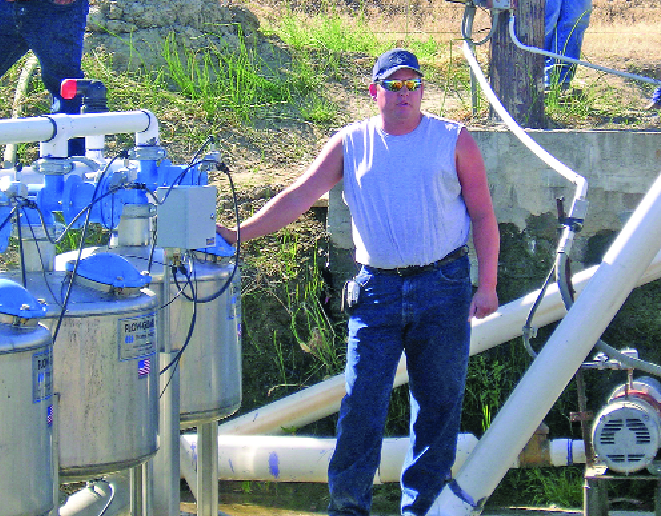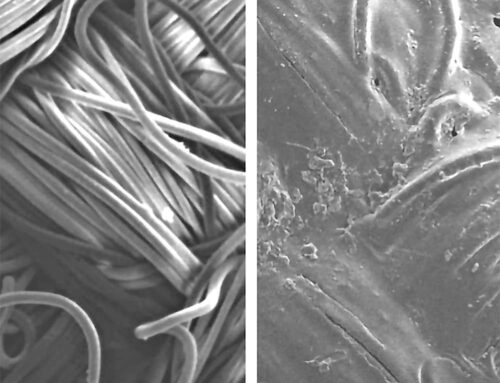
John Neimeyer of Airport Ranches talks about the pump controlling the newly installed drip irrigation system at the Outlook vineyard. Photo by Anne Sampson
By Anne Sampson
Researchers and growers teamed up at the Washington State Grape Society’s field day this summer to demonstrate the benefits of drip irrigation and controlled pruning methods in Concord grapes. The group was also updated on research at Washington State University’s Irrigated Agriculture Research and Extension Center on possible causes and prevention of chlorosis.
A group of about 30 gathered at Airport Ranches, where Assistant Foreman John Neimeyer sang the praises of drip irrigation. The 65-acre vineyard where they stood swept down a gentle slope, dark green and lush. Over the last few dry years, the plot had suffered with uneven canopies and areas of stress due to poor water distribution. Neimeyer and his crew last spring spent about a week converting the vineyard to a drip irrigation system.
Dramatic reduction
“Out of the 1,100 acres here” at Airport Ranches, Neimeyer said, “this one vineyard used to take about a quarter of our whole water allotment.” Now, where Neimeyer once ran sprinklers to spread 30 points of water for nine straight days, he uses 25 points for three days. Points refer to the depth of water flow over a weir.
The conversion cost about $1,000 an acre, an expensive undertaking. But the alternative—seeking other land to rent in order to secure more water rights—could have cost about a third more. “In all the years we’ve farmed here, it looks better than it ever has,” he said. “I can tell just by looking at it that it was well worth the time and money.” At another, newer plot, Neimeyer pointed out canopies on the young plants that nearly reached the ground.
The Concord vineyard was started on a drip system when it was planted in the fall of 2004, and by mid-July, 75 to 80 percent of the vines were on the wire, Neimeyer said. In fact, he pointed out, the drip acres showed 18 inches more growth than another 1-1/3 acres on sprinklers. The difference? “It’s getting water where it needs it.” Besides the more efficient method of distributing the water, Neimeyer said the drip system also improved efficiency in the farm’s storage lake.
One hundred fifty gallons are returned to the lake with every 400 removed, stretching the lake’s capacity from two or three days to as much as two weeks. “I wouldn’t be afraid to put drip in any vineyard, I don’t care how old it is,” he said. At Olsen Brothers Farms, Production Manager Keith Oliver showed similar results at a more than 20-year-old vineyard converted in 2001 to a drip system. “It was rill-irrigated with a pipe running through the middle,” he said. “When we converted to drip, we saw benefits immediately.
Minimal pruning
Oliver also discussed the good results he got from minimally pruning the vineyards. The mechanical pruning methods he once used were causing too much breakage. By minimally pruning just the bottom skirt of the canopy, he significantly reduced labor costs, while improving yields.
The switch meant he had to raise the cordon wire to five feet, and let the buds move to the top of the plant where they see more sun. Minimal pruning is essential in a vineyard trained to a double-curtain canopy because the fruit tends to grow between the cordons, and mechanical harvesters break off too much of that wood. An experiment last year with a few rows of minimally pruned double-canopy grapes were encouraging, Oliver said.
This year, he is trying it on half of two different fields covering about 22 acres. That way he’ll be able to compare yield and sugar content between the minimally pruned plants and those pruned mechanically. “Our double-curtain Concord vineyard was the hardest pruning we had to do,” he said. By removing just the lower skirt with minimal methods, then following up with a little hand pruning, “we eliminated the need for skilled labor. We’re hoping yields will be larger, but time will tell.”
Chlorosis
The group also heard from Dr. Joan Davenport of WSU’s Irrigated Agriculture Research and Extension Center in Prosser, along with Dr. Markus Keller, also from WSU IAREC, who reported on chlorosis research, a condition caused by water stress and an iron deficiency in the plant during the bud-to-bloom period.
The WSU studies show that its occurrence varies throughout a given area, suggesting that differences in soil conditions might be at play, along with differences in the plants themselves. “One of the things we’re doing is looking at soils, to see whether iron is present in a chelated form, and if that increases the amount of biologically available iron,” Davenport said. Chelated iron is “wrapped” in organic compounds that keep it soluble in soil.
Lab tests conducted at Cornell University will measure the amount of total iron in both chlorotic plants and healthy plants, and compare it to the amount of biologically active iron. A difference might indicate rootstocks that are unable to absorb iron in certain forms. Increased moisture in the soil might also affect the available iron supply. “We definitely see that when we have chlorosis, or when it’s really bad, the soils are wet or wetter during the bud-break to bloom period.
We think there’s a limit on the plant’s ability during this high-demand period for the plants to get enough iron out of the soil,” Davenport said. Keller’s work is focused on grafting plants onto chorosis-resistant rootstocks, and on the role of pH in soils where Concord vines show a lot of the disorder.
Concords originated in New England, he noted, where the soils have very low pH, and where vineyards are free of chlorosis. This year he launched a study of the effectiveness of grafting vines onto pH-tolerant rootstocks. Keller said he should be able to see results from his study after three or four years of trials.




Leave A Comment